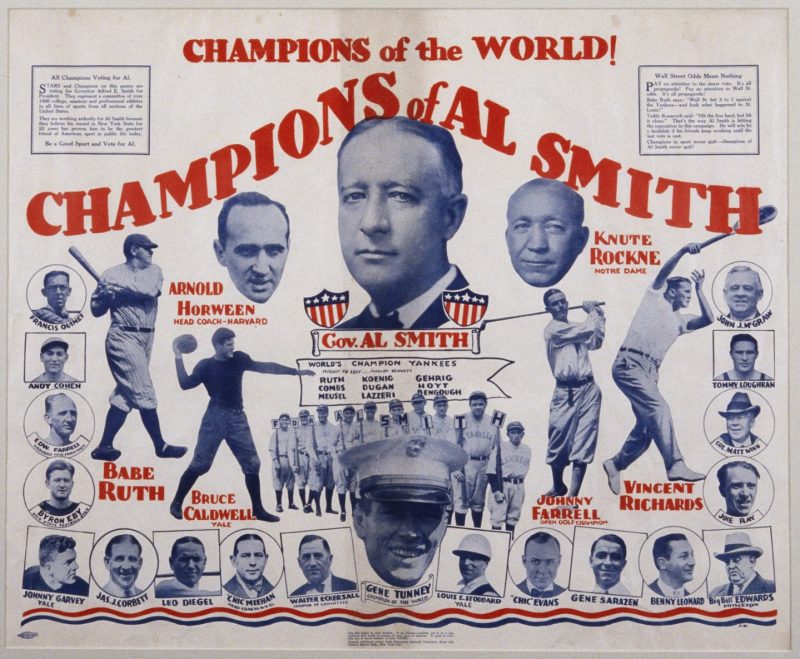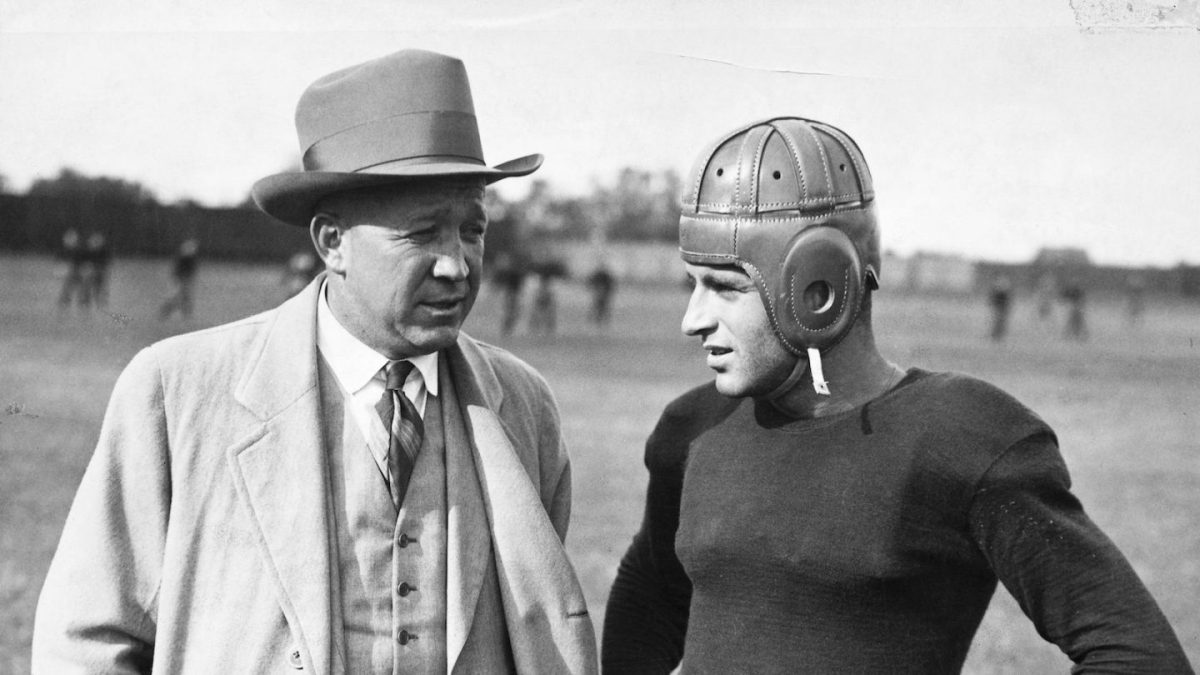“I went to South Bend with a suitcase and $1,000, feeling the strangeness of being a lone Norse Protestant invading a Catholic stronghold,” Knute Rockne wrote of his arrival at Notre Dame in 1910, where he enrolled at age 22. He remained there until he died at just 43 in 1931. First as a student (he graduated magna cum laude in chemistry and pharmacology) and All-American player, then an assistant and finally as head coach, he played a vital role in transforming college football and ensuring the Fighting Irish had a following that refused to be contained by Indiana borders.
But Rockne’s impact goes beyond the gridiron. This Norwegian immigrant was essential to the Irish being accepted in America. Even in death he caused innovation, inspiring huge advances in aviation safety. In honor of his 130th birthday, this is why Knute Rockne continues to be the rare athletic icon with a legacy beyond sports.
On the Field
Rockne would be a significant footnote in football history even if he’d never moved into coaching. Despite being small by the standards of any era—he stood 5’8” and his weight has been reported at just 145 pounds—he helped quarterback Charles “Gus” Dorais develop the forward pass in 1913. Playing at West Point against favored Army, Notre Dame proved that passing could be more than a gimmick to set up the run. Dorais completed 14 of 17 passes for 243 yards in a 35-13 win, with Rockne catching a touchdown.
When his playing career ended, Rockne became a Notre Dame assistant and finally head coach in 1918. With his career prematurely shortened by his tragically young death, he coached only 13 seasons. (Alabama’s Nick Saban is at 22 and counting, not including his time in the NFL.) Rockne coached 122 games and had 105 wins, 12 losses and 5 ties, accumulating what remains the highest career winning percentage for major college football: .881. He went undefeated five seasons while winning three national titles.
Rockne continued to demonstrate the appeal of the passing game, helping lay the foundations for the Bradys and Breeses of the modern era. (It’s worth remembering this is extremely early in football’s history: Vince Lombardi was 17 at the time of Rockne’s death and wouldn’t take over the Green Bay Packers for another 28 years.) Rockne’s players included the celebrated “Four Horsemen” of quarterback Harry Stuhldreher, left halfback Jim Crowley, right halfback Don Miller and fullback Elmer Layden, as well as All-American halfback George Gipp. Gipp’s death at 25 gave future President Ronald Reagan his most famous role in the 1940 film Knute Rockne, All American.
Rockne showed a genius for football and promotion, whether of Notre Dame, football or himself. (He wrote the book Coaching: The complete Notre Dame system of Football, with a cover noting it was “Written by the Game’s Greatest Coach.”) Hollywood later did Rockne proud by taking his knack for exaggeration and crossing over to outright invention. Example: The phrase “Win one for the Gipper” remains famous as both George Gipp’s dying utterance and the inspiration for a legendary Rockne halftime speech. In the film, that rousing address went something like this:
However, Rockne didn’t hear Gipp’s last words. Nor did he invoke him at halftime. And this is what he actually sounded like.
While we remember many myths about Rockne, we’ve forgotten much of his true importance. These are two ways he shaped America outside the stadium.
Norway’s Irish Icon
Notre Dame was founded in 1842, but it took many decades before it got that “Fighting Irish” nickname. The first usage may have been as early as 1909, but the team was still commonly referred to as other things. For instance, school publications often called them the “Gold and Blue.”
The press beyond campus found more colorful terms, including “Papists,” “Dumb Micks” and “Dirty Irish.”
When Rockne took over Notre Dame football, John F. Kennedy was just 16 months old. Rockne led a team that came to symbolize Irish-American Catholics at a time when much of the country would have preferred that such people go away. (Or at least stay out of view, instead of making headlines for dominating on the football field.)
This was particularly true in Indiana. The Ku Klux Klan is best known for its hatred of blacks, but they came to despise Jews and Catholics nearly as deeply. In 1925, the Klan had an estimated 250,000 members in Indiana. Indeed, for a time they effectively controlled the state government. Their reign only ended when Indiana’s Grand Dragon was convicted of rape and murder—he then decided to destroy his allies for failing to keep him out of prison.
Tensions between Notre Dame and the KKK exploded in 1924 when thousands of students nearly battled the Klan over a rally in South Bend. Rockne spoke at a campus event to help avert full-on combat.
Gradually, Notre Dame chose not to resist the mocking nicknames but embrace them. Well, one of them. In 1927, Notre Dame President Rev. Matthew Walsh issued a statement: “The university authorities are in no way averse to the name ‘Fighting Irish’ as applied to our athletic teams.” Indeed, he said he hoped “we may always be worthy of the ideal embodied in the term ‘Fighting Irish.’”
Irish pride came a little easier knowing they had picked up their first national title in 1925, beating Stanford at the Rose Bowl.
That was the year Rockne converted to Catholicism. He also gave his support to the most prominent Irish-American Catholic leader of his generation. New York governor Al Smith won the Democratic nomination for president in 1928, the first Roman Catholic to do so. Smith came from a fairly diverse background (he had some German and Italian heritage), but he was firmly associated with Irish Americans.

It seemed like Irish Catholics were on the verge of making history, with Rockne, Babe Ruth and other celebrities giving him their full endorsements.
Then Herbert Hoover received 58 percent of the popular vote. While Rockne had helped move the chains a great distance during his life, it would be nearly 30 years after his death that JFK won the presidency and an Irish Catholic finally reached the White House.
One Final Gift
The last part of Rockne’s legacy was decidedly not by design. Rockne had been flying to Los Angeles to participate in the film The Spirit of Notre Dame. He was one of eight casualties when his plane crashed in Kanas in 1931. His death drew massive national attention. Years later, Notre Dame coach Ara Parseghian—who led Notre Dame to two national titles of his own and coached players including Joe Montana and Daniel Eugene Ruettiger (better known as “Rudy”)—recalled newsboys selling special editions to specifically announce the tragedy.
The public was heartbroken. Then angry, confused and scared. While America has lost a depressing number of celebrities to plane crashes, this was before those tragedies seemed almost commonplace. (The crash that killed Buddy Holly, Ritchie Valens and “The Big Bopper” didn’t occur until 1959.) America wanted to know exactly how dangerous air travel was. Should it be avoided altogether? The entire infant flight industry seemed at risk.
As the US National Library of Medicine notes, “The response to the crash of the F-10A transport that killed Rockne was to ground all the planes.” Which was fortunate, because the cause of the crash was truly horrifying: the plane’s wing had completely snapped off. How? For starters, the wing was made of wood. Yes, Rockne’s death finally caused airlines to consider that just maybe their aircraft should not have wooden wings. It also helped establish protocols for investigating crashes and a general drive to build better airliners, culminating in the creation of the DC-3 in 1936.
Would air travel have grown safer eventually regardless? No doubt, but the attention brought by Rockne accelerated the time frame. Unquestionably Knute Rockne’s death prevented other crashes and his passing saved other lives.
A Coach We Keep With Us
Today, Rockne is in the strange position of being known more for his legend (and myths) than his actual legacy. Yet he is remembered while equally great coaches are forgotten. Bud Wilkinson won three national titles and led his Oklahoma team on a staggering 47-game winning streak, the longest by far in college history. But his name is little known outside Sooner country.
On a seemingly daily basis, coaches like Steve Kerr invoke Rockne.
Football today has many great coaches. But 50 years after Bill Belichick’s death, will he still lend himself to classic punch lines? Rockne did precisely that for 1980’s Airplane! It’s just one of the ways a child from Norway grew up to transcend ethnicity, religion and even the sport that made him famous in the first place. As Rockne quipped, “One loss is good for the soul. Too many losses are not good for the coach.”
Whether you’re looking to get into shape, or just get out of a funk, The Charge has got you covered. Sign up for our new wellness newsletter today.























